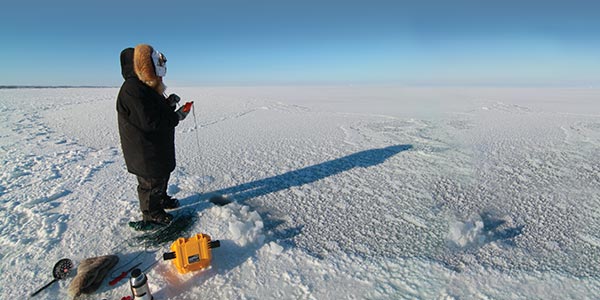Mission: Water | On A New Kind Of Hunt | Gathering Data Under Hudson Bay Ice
The hunters recognized the changes. A shot seal would usually float, buoyed by its blubber atop the dense salt water of Canada’s Hudson Bay. Now the seals were sinking below the surface before the hunters could reach them. Check out the latest article from Mission: Water magazine that follows the Inuit hunters from five Hudson Bay communities as they gather data on the massive fresh water plume that is changing their environment.
>> Download copy of Mission: Water Magazine
>> Download this Article Only
Below is a short teaser:
Heath’s first winter on the ice in 2002 coincided with a landmark agreement between the Cree people of Quebec, the federal government and the government of Quebec that permitted the completion of the second phase of the James Bay Project. The massive hydroelectric venture, begun in the 1970s, was already one of  the largest hydropower systems in the world. By the end of construction on Phase II, it would include eight hydroelectric generating plants and divert many of the rivers in eastern Canada to drain through the mouths of the Rupert River and the La Grande—just off the Belcher Islands.
the largest hydropower systems in the world. By the end of construction on Phase II, it would include eight hydroelectric generating plants and divert many of the rivers in eastern Canada to drain through the mouths of the Rupert River and the La Grande—just off the Belcher Islands.
What’s more, the dam releases that drive the hydroelectric turbines don’t follow the ebb and flow of the region’s normal hydrological cycle.
“Electrical demand is highest in the winter,” Heath explains. “Usually we’d have flooding, our highest flows, in the spring. The hydrological cycle has been reversed. Rivers have been re-routed, and it all comes over to southeast Hudson Bay.”
Fresh water freezes at a higher temperature than saltwater does. The ice it forms is clear and brittle, which means freshwater floes behave differently than sea ice, interfering with normal flow patterns. And fresh water freezes more quickly than sea ice does, which is why whales can find themselves caught in the ice, as they did in 2013 when more than 70 belugas were trapped under a shrinking hole and mauled by polar bears.
In 2011, Heath released People of a Feather to raise awareness of the challenges faced by the residents of the Belcher Islands. That year, he also established the Arctic Eider Society as a foundation for fundraising and a focal point to study the science and community impact of the changing water. Working with the local communities, Environment Canada, University of Manitoba and other stakeholders, he set the course for a sweeping study of water and ice across the region.
Mission: Water is a new magazine featuring the organizations and researchers who tackle the world’s most challenging water issues. It highlights the latest trends in instrumentation and research applications, while also offering additional educational resources on environmentally-focused matters.
Our goal is to help you stay informed about topics relevant to you. Our inaugural edition covers articles ranging from monitoring Nepal’s sacred rivers to examining coral bleaching events off the coast of Panama; research on fish diversity and nutrient recycling in Africa’s Lake Tanganyika and much more!
Download the inaugural edition for free!


Additional Blog Posts of Interest:
Sacred Stream: Expedition on Nepal’s Bagmati River
Olympic Hopeful: Why Rio’s Water Isn’t Making the Cut
The Evolution of Water Quality Monitoring [Free eBook]
Lake Oconee Water Quality Protected with Optical Technology